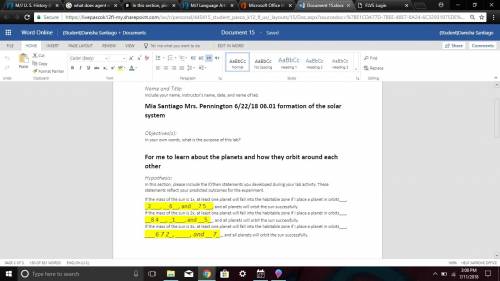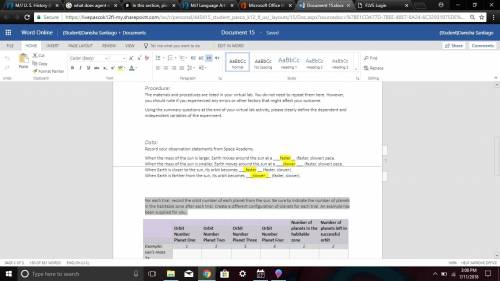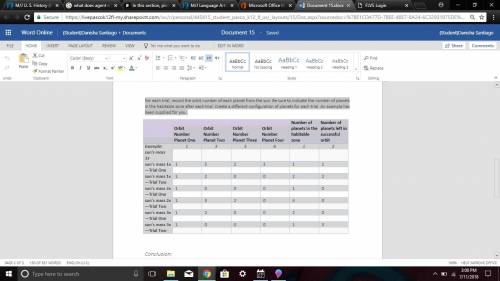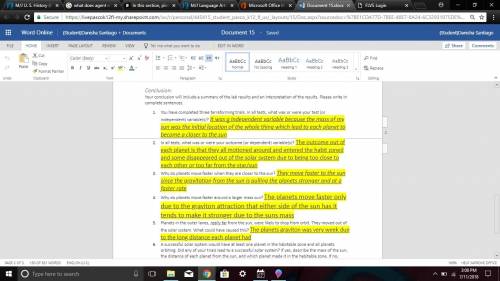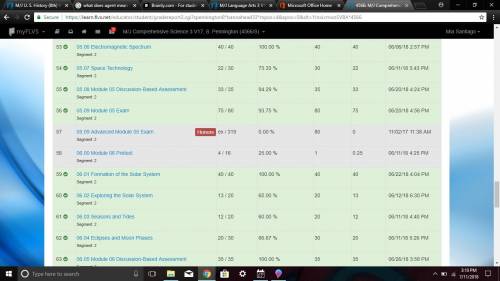
Biology, 12.10.2019 19:30, robert7248
In this section, include the if/then statements you developed during your lab activity. these statements reflect your predicted outcomes for the experiment.
if the mass of the sun is 1x, at least one planet will fall into the habitable zone if i place a planet inand and all planets will orbit the sun successfully.
if the mass of the sun is 2x, at least one planet will fall into the habitable zone if i place a planet inand and all planets will orbit the sun successfully.
if the mass of the sun is 3x, at least one planet will fall into the habitable zone if i place a planet inand and all planets will orbit the sun successfully.
procedure:
the materials and procedures are listed in your virtual lab. you do not need to repeat them here. however, you should note if you experienced any errors or other factors that might affect your outcome.
using the summary questions at the end of your virtual lab activity, clearly define the dependent and independent variables of the experiment.
data:
record your observation statements from space academy.
when the mass of the sun is larger, earth moves around the sun at a (faster, slower) pace.
when the mass of the sun is smaller, earth moves around the sun at a (faster, slower) pace.
when earth is closer to the sun, its orbit becomes (faster, slower).
when earth is farther from the sun, its orbit becomes (faster, slower).
for each trial, record the orbit number of each planet from the sun. be sure to indicate the number of planets in the habitable zone after each trial. create a different configuration of planets for each trial. an example has been supplied for you.
orbit number
planet one orbit number
planet two orbit number
planet three orbit number
planet four number of planets in the habitable zone number of planets left in successful orbit
example: sun's mass 1x
1
3
5
6
1
2
sun's mass 1x—trial one
sun's mass 1x—trial two
sun's mass 2x—trial one
sun's mass 2x—trial two
sun's mass 3x—trial one
sun's mass 3x—trial two
conclusion:
your conclusion will include a summary of the lab results and an interpretation of the results. write in complete sentences.
you have completed three terraforming trials. in all tests, what was or were your test (or independent) variable(s)?
in all tests, what was or were your outcome (or dependent) variable(s)?
why do planets move faster when they are closer to the sun?
why do planets move faster around a larger mass sun?
planets in the outer lanes, really far from the sun, were likely to drop from orbit. they moved out of the solar system. what could have caused this?
a successful solar system would have at least one planet in the habitable zone and all planets orbiting. did any of your trials lead to a successful solar system? if yes, describe the mass of the sun, the distance of each planet from the sun, and which planet made it in the habitable zone. if no, describe what changes you could make in future trials to meet the criteria for a successful solar system.

Answers: 3
Similar questions

Chemistry, 19.07.2019 20:10, maddylife
Answers: 3

Chemistry, 18.11.2019 08:31, leasincobe4327
Answers: 1

Physics, 19.11.2019 21:31, wolfiewolffromsketch
Answers: 2
Do you know the correct answer?
In this section, include the if/then statements you developed during your lab activity. these state...
Questions in other subjects:

Social Studies, 25.01.2021 23:50

Mathematics, 25.01.2021 23:50


Mathematics, 25.01.2021 23:50



Arts, 25.01.2021 23:50


Social Studies, 25.01.2021 23:50


